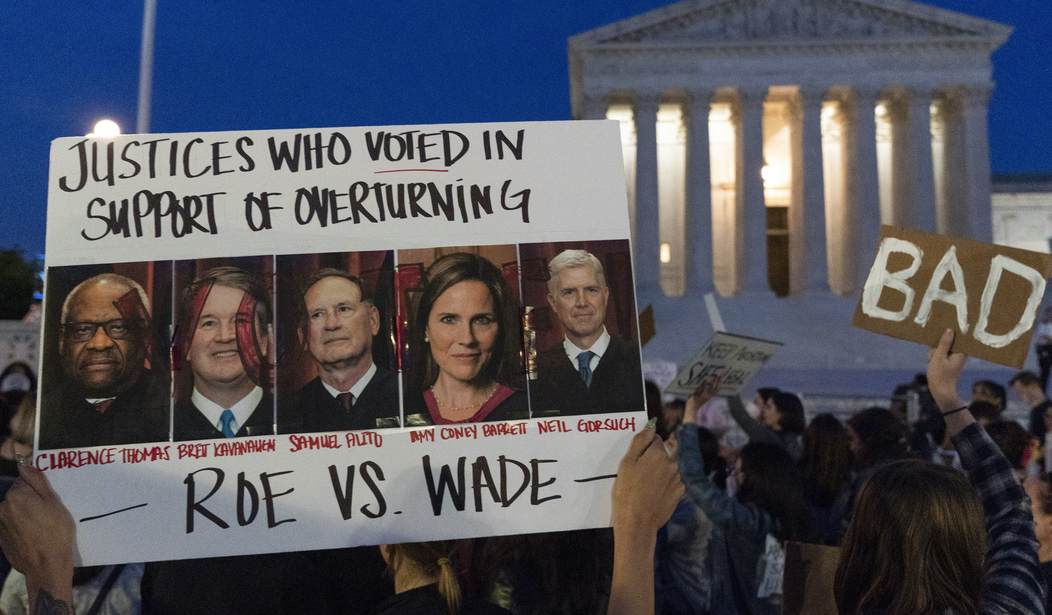We can expect a slew of reporting on Nicholas Roske over the next few days to paint him as a troubled and mentally ill man. That has already begun to unfold, in fact, but it won’t distract from the reality of Roske’s clear plan and actions to carry out an assassination of a sitting Supreme Court justice.
Today’s Washington Post headline of its coverage of Roske’s 911 call suggest that he had second thoughts, but the actual report focuses on just how well Roske planned for an assassination:
Fresh off a flight from California, Nicholas Roske grabbed a cab to the home of Supreme Court Justice Brett M. Kavanaugh, according to court records. It was 1 a.m.
What he had packed in his bags, law enforcement officials said Thursday, underscored just how serious he was at carrying out his plan to kill the conservative justice: burglary tools, a gun and a pair of made-to-be-quiet boots with outer soles that could allow stealth movement inside a house.
“The boots with padding really raised red flags,” said Capt. Sean Gagen, commander of the Montgomery County Police Department’s Bethesda district.
This wasn’t just an impulse move, in other words. Roske had a clear intent not just to kill Kavanaugh but also to at least disable other members of the household. According to the indictment, Roske’s bag didn’t just include a gun and some “burglary tools”:

You don’t need zip ties, pepper spray, and duct tape to carry out a simple shooting. That’s a kidnapping kit, meant to force people into restraints. Everything in that bag raises red flags, and more.
That inventory does more than raise red flags, though. It demonstrates a clear and rational preparation for premeditated murder and kidnapping. That will belie the all-but-certain defense of insanity, which Roske began setting up with the 911 call, and later in court as well:
During his initial court appearance on federal charges of attempting to kill or kidnap a US judge, Roske was asked if he understood what was happening and whether he was thinking clearly.
“I think I have a reasonable understanding, but I wouldn’t say I’m thinking clearly,” he said.
Roske added that was taking medication, but didn’t elaborate on what it is or why he is on it. …
Roske’s grandfather, Dan Shannon, insisted late Wednesday the charges against his grandson were “extremely” out of character.
“He’s a good kid,” he told CBS Los Angeles.
Not any more, clearly. Roske told police from the start that he needs “psychiatric help,” which is certainly believable but hardly an entrée to an insanity plea:
“I need psychiatric help,” Roske told the 911 operator soon after 1 a.m. Wednesday.
Roske, 26, reported having suicidal and homicidal thoughts, according to court documents, but those words were blanked out in the audio clip released Thursday. Roske, however, could be heard saying, “I’ve been having them for a long time.” He also said he has been hospitalized many times.
He then told the operator that he had a gun but that it was unloaded and locked in his suitcase. He also said the suitcase contained pepper spray, a knife and “tools.”
Asked whether he came to Maryland to hurt himself and Kavanaugh, Roske, who is from California, said, “Correct.” But he called 911 because, he said, “I want to be fully compliant.”
Two points in particular here will negate any attempt to win an insanity defense. First, Roske didn’t just decide to stop; he only stopped when he saw armed security outside Kavanaugh’s residence. That shows that Roske was sane enough to make a rational calculation that his plan wouldn’t succeed. His call to 911 was likely also a rational calculation that his sudden appearance on Kavanuagh’s street had raised an alarm with those security personnel (US Marshals in this case), which it had, and that he would be apprehended one way or another.
The second reason an insanity defense won’t work is because Roske clearly understood that he was committing a crime. His abduction kit shows he prepared for this as a crime, arguably, as did his attempt to stealth-enter the Kavanaugh home with the wrapped boots and all-black clothing. In the US, the traditional qualification for an insanity defense is the so-called “M’Naghten Rule,” which requires the defendant to be so deranged as to not have any awareness of right and wrong. Any preparations for a crime that hints at such knowledge — such as wrapped boots, dark clothing, premeditation in general — would negate such an argument. There are also other models for an insanity defense, but most of them come down to the same points, and all of them would be negated by premeditation.
Maryland uses the “Model Penal Code” test for legal insanity, which is a little more broad in terms of qualifications. However, for Roske, it’s still the same problem:
Under the MPC test a criminal defendant is not guilty by reason of insanity if he is diagnosed with a relevant mental defect (for example, severe mental retardation or schizophrenia disorder) and at the time of the incident was unable to either:
- Appreciate the criminality of his conduct; or
- Conform his conduct to the requirements of the law
Therefore, using the MPC test, a legally insane individual must have been diagnosed with a mental defect (typically by a court-appointed mental health professional) and either did not know right from wrong or lacked the ability to control an impulse that led to the incident.
In federal court, it’s even more limited, thanks to John Hinckley. The Federal Insanity Defense Reform Act of 1984 reversed previous law that placed the burden of proving sanity on the prosecution and forced the defense to prove insanity. It also removed the “irresistible impulse test” as a form of insanity defense. The new law, 18 USC 17, is very similar to the M’Naghten Rule and the Model Penal Code:
(a)Affirmative Defense.—
It is an affirmative defense to a prosecution under any Federal statute that, at the time of the commission of the acts constituting the offense, the defendant, as a result of a severe mental disease or defect, was unable to appreciate the nature and quality or the wrongfulness of his acts. Mental disease or defect does not otherwise constitute a defense.
(b)Burden of Proof.—
The defendant has the burden of proving the defense of insanity by clear and convincing evidence.
The fact that Roske turned around after finding armed security makes it impossible for his attorneys to meet the threshold on either test. He clearly understood that it was wrong, and Roske also had enough impulse control to abandon his plan when he realized he couldn’t accomplish it. Even if Roske’s lawyers can get a psychiatrist to diagnose him as a schizophrenic, his actions demonstrate rationality and purpose, even for an irrational end.
The Washington Post notes that Roske’s about-face probably won’t save him in a traditional sense, either. He took enough actions towards accomplishing his goal to legally qualify his acts as attempted murder, especially by coming to Kavanaugh’s street:
As a legal matter, the fact that Roske didn’t follow through on his alleged plans might not necessarily help him, analysts said.
All of the actions Roske took, at least according to the FBI affidavit, probably put him over the threshold of “substantial steps beyond mere preparation” that is generally required to be convicted of attempted murder in federal court, according to Robert Bonsib, a defense attorney in Maryland.
“His steps, as stated in the affidavit, were so substantial and well down the road towards completing the crime that an abandonment defense may be difficult,” Bonsib said.
In other words, Roske’s going to prison, and he will be there a long, long time. Perhaps he’ll get some “psychiatric help” over those years, but it won’t be in a psychiatric prison.








